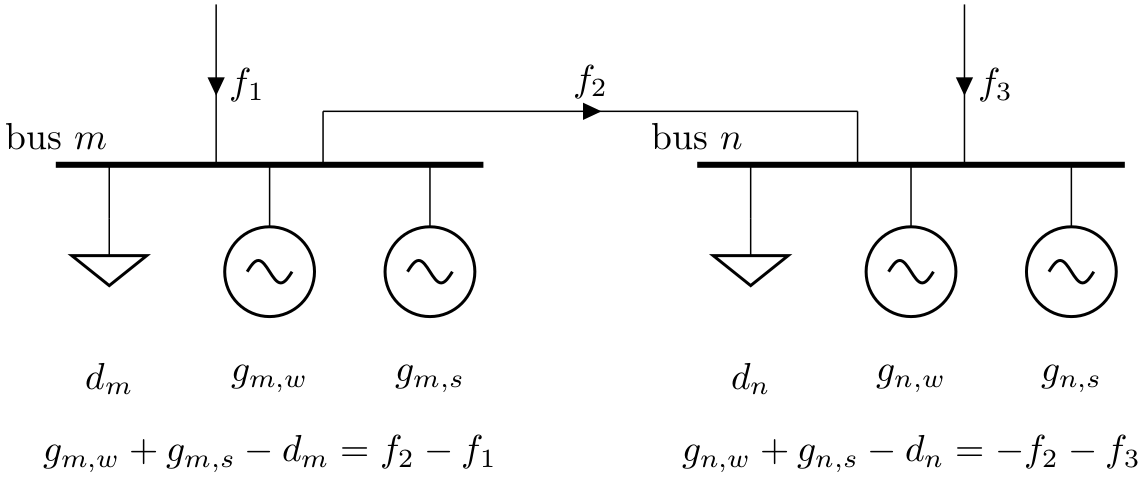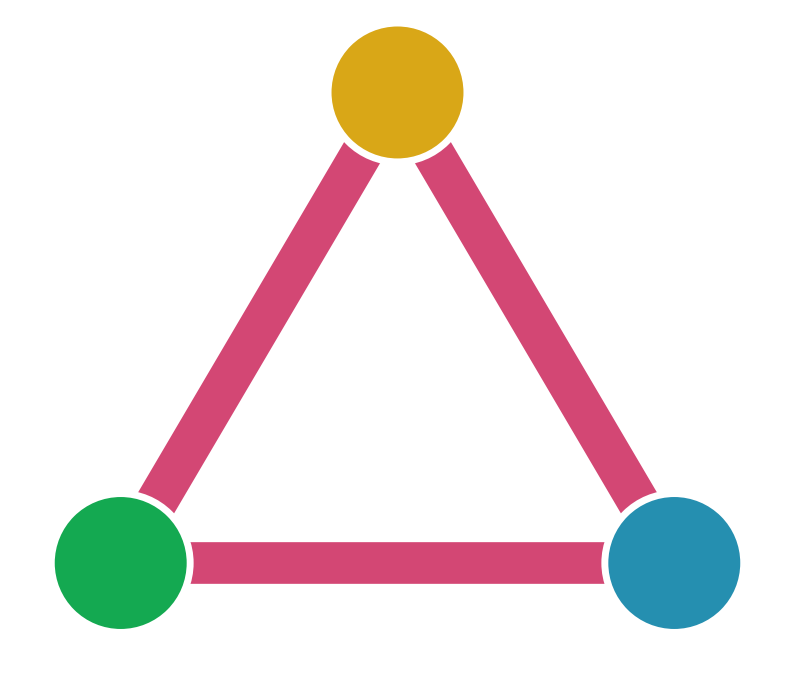Design#
Network object is the overall container#
The pypsa.Network is an overall container for all network components;
components cannot exist without a network. It is also the object on which
calculations, such as power flow and optimal power flow, are performed.
Buses are the fundamental nodes#
The bus is the fundamental node to which all loads, generators, storage units, lines, transformers and links attach. You can have as many components attached to a bus as you want. The bus’s role is to enforce energy conservation for all elements feeding in and out of it (i.e. like Kirchhoff’s Current Law).

Energy flow in the model#
Energy enters the model in generators, storage units or stores with higher energy before than after the simulation, and any components with efficiency greater than 1 (e.g. heat pumps).
Energy leaves the model in loads, storage units or stores with higher energy after than before the simulation, and in lines, links or storage units with efficiency less than 1.
Data is stored in pandas DataFrames#
To enable efficient calculations on the different dimensions of the data, data is stored in memory using pandas DataFrames.
Other power system toolboxes use databases for data storage; given modern RAM availability and speed considerations, pandas DataFrames were felt to be preferable and simpler.
To see which data is stored for each component, see Components.
Static component data#
For each component type (line, transformer, generator, etc.), which must be uniquely named for each network, its basic static data is stored in a pandas DataFrame, which is an attribute of the network object, with names that follow the component names:
network.busesnetwork.generatorsnetwork.loadsnetwork.linesnetwork.transformers
These are all pandas DataFrames, indexed by the unique name of the component.
The columns contain data such as impedance, capacity and the buses to
which components are attached. All attributes for each component type
are listed with their properties (defaults, etc.) in Components
and are accessible from the network object in
e.g. network.components["Bus"]["attrs"].
Network components cannot exist without a network to hold them.
Time-varying data#
Some quantities, such as generator p_set (generator active power
set point), generator p (generator calculated active power), line
p0 (line active power at bus0) and line p1 (line active
power at bus1) may vary over time, so PyPSA offers the possibility
to store different values of these attributes for the different
snapshots in network.snapshots in the following attributes of the
network object:
network.buses_tnetwork.generators_tnetwork.loads_tnetwork.lines_tnetwork.transformers_t
These are all dictionaries of pandas DataFrames, so that for example
network.generators_t["p_set"] is a DataFrame with columns
corresponding to generator names and index corresponding to
network.snapshots. You can also access the dictionary like an
attribute network.generators_t.p_set.
Time-varying data are defined as series in the listings in Components.
For input data such as p_set of a generator you can store the
value statically in network.generators if the value does not
change over network.snapshots or you can define it to be
time-varying by adding a column to network.generators_t.p_set. If
the name of the generator is in the columns of
network.generators_t.p_set, then the static value in
network.generators will be ignored. Some example definitions of
input data:
#four snapshots are defined by integers
network.set_snapshots(range(4))
network.add("Bus", "my bus")
#add a generator whose output does not change over time
network.add("Generator", "Coal", bus="my bus", p_set=100)
#add a generator whose output does change over time
network.add("Generator", "Wind", bus="my bus", p_set=[10,50,20,30])
In this case only the generator “Wind” will appear in the columns of
network.generators_t.p_set.
For output data, all time-varying data is stored in the
network.components_t dictionaries, but it is only defined once a
simulation has been run.
Internal use of per unit#
Per unit values of voltage and impedance are used internally for network calculations. It is assumed internally that the base power is 1 MVA. The base voltage depends on the component.
Unit Conventions#
The units for physical quantities are chosen for easy user input.
The units follow the general rules:
Quantity |
Units |
|---|---|
Power |
MW/MVA/MVar (unless per unit of nominal power, e.g. generator.p_max_pu for variable generators is per unit of generator.p_nom) |
Time |
h |
Energy |
MWh |
Voltage |
kV phase-phase for bus.v_nom; per unit for v_mag_pu, v_mag_pu_set, v_mag_pu_min etc. |
Angles |
radians, except transformer.phase_shift which is in degrees for easy input |
Impedance |
Ohm, except transformers which are pu, using transformer.s_nom for the base power |
CO2-equivalent emissions |
tonnes of CO2-equivalent per MWh_thermal of energy carrier |
Sign Conventions#
The sign convention in PyPSA follows other major software packages, such as MATPOWER, PYPOWER and DIgSILENT PowerFactory.
The power (p,q) of generators or storage units is positive if the asset is injecting power into the bus, negative if withdrawing power from bus.
The power (p,q) of loads is positive if withdrawing power from bus, negative if injecting power into bus.
The power (p0,q0) at bus0 of a branch is positive if the branch is withdrawing power from bus0, i.e. bus0 is injecting into branch
Similarly the power (p1,q1) at bus1 of a branch is positive if the branch is withdrawing power from bus1, negative if the branch is injecting into bus1
If p0 > 0 and p1 < 0 for a branch then active power flows from bus0 to bus1; p0+p1 > 0 is the active power losses for this direction of power flow.
AC/DC Terminology#
AC stands for Alternating Current and DC stands for Direct Current.
Some people refer to the linearised power flow equations for AC networks as “DC load flow” for historical reasons, but we find this confusing when there are actual direct current elements in the network (which also have a linearised power flow, which would then be DC DC load flow).
Therefore for us AC means AC and DC means DC. We distinguish between the full non-linear network equations (with no approximations) and the linearised network equations (with certain approximations to make the equations linear).
All equations are listed in the section Power Flow.
Set points are stored separately from actual dispatch points#
Dispatchable generators have a p_set series which is separate from the calculated active power series p, since the operators’s intention may be different from what is calculated (e.g. when using distributed slack for the active power).
